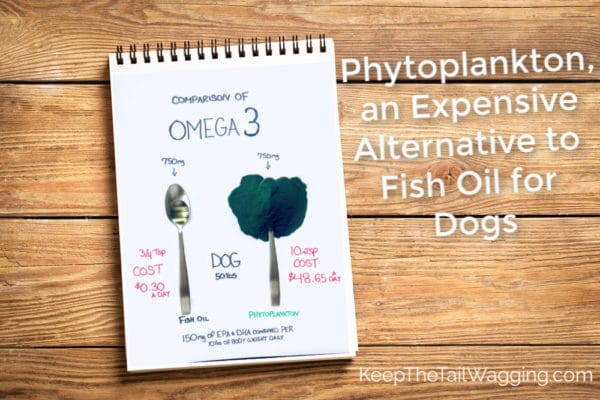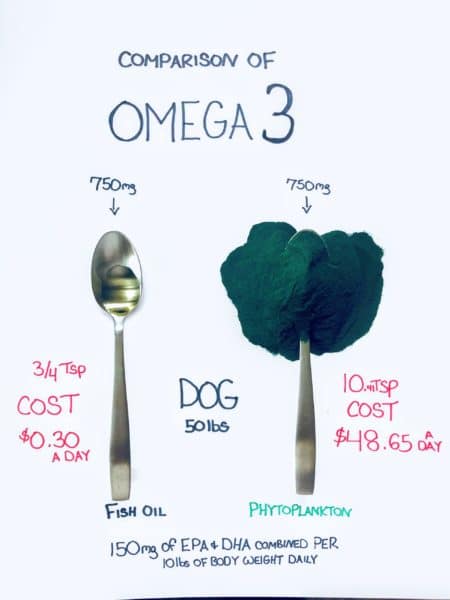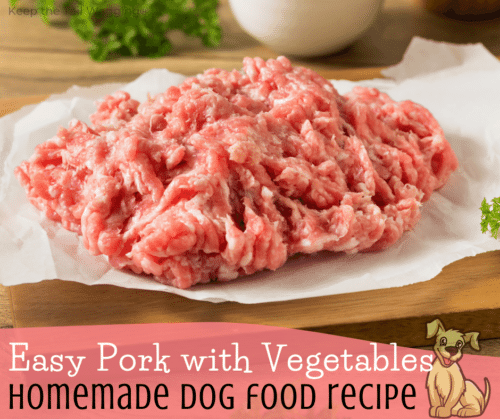Keep the Tail Wagging is supported by pet parents. I occasionally earn a commission (at no additional cost to you) when you click through an affiliate link to one of my favorite products. Thank you for your support. Read More
Welcome to Raw Foodie Friday! Today, we're going to talk about a supplement that I've been giving my dogs and promoting as a superior alternative to fish oil. This year, I decided to focus on reducing my raw feeding budget, and I'm taking a closer look at the foods and supplements I buy for my dogs and cat. This deep dive now has me questioning what I believed about phytoplankton.
A couple of years ago, I wrote a blog post explaining why I don't give phytoplankton to my dogs. I wasn't convinced that it was an affordable alternative and I questioned being able to find a quality source. Despite my initial thoughts, I continued to do my homework and changed my mind when I did find an affordable source, however, today, I wonder if my first instincts were correct. Is phytoplankton affordable?
What is Phytoplankton?
It's easy to make the mistake and think phytoplankton is a type of seaweed, but this isn't correct. Phytoplankton is micro-algae in the plankton family, while seaweed is a macro-algae. “Plankton are the diverse collection of organisms that live in large bodies of water and are unable to swim against a current. They provide a crucial source of food to many large aquatic organisms, such as fish and whales.” ~ Wikipedia
Phytoplankton is now on many lists of Super Foods because of the benefits (listed below) and it's said to be less toxic than fish oil and salmon oil while protecting our oceans from over-fishing.
Benefits of Phytoplankton for Dogs
Despite what I share in this blog post, the benefits of phytoplankton haven't changed and I'll continue adding it to my smoothies now that I'm on an “I need to get healthy” kick and my dogs' meals.
* cancer-killing potential due to single-celled plankton called dinoflagellates
* reduces oxidative damage and inflammation while naturally helping the body detox
* aids the body in strengthening existing cells and generating new cells
* is a superior source of Omega 3 fatty acids (DHA & EPA), which supports heart, skin, coat, and joint health
* supports liver health by not overtaxing the liver and helping with detox
Nutritional Analysis of Phytoplankton for Dogs
I've been giving my dogs phytoplankton formulated for pets, which is available on Amazon.com. They were kind enough to send me several packages recently because I'm such a fan. They also shared their Certificate of Analysis with me because I was curious about the nutrient makeup of phytoplankton, and this isn't the information that you can easily find online.
One thing that's clear from the Certificate of Analysis is that phytoplankton is rich in chlorophyll, which is fantastic. If you have a dog that is constantly dining on grass, it could be because your dog has a digestive issue OR it could be because your dog is supplementing his or her diet with the chlorophyll that is present in the grass.
What's NOT so clear in the Certificate of Analysis is the Omega 3 fatty acid levels because I'm not used to reading these types of documents.
In the “fatty acids” section, there are ratios that don't make a lot of sense to me, so I asked Google. There are two major classes of polyunsaturated fatty acids (PUFAs), Omega 3 and Omega 6 fatty acids. The ratios we see represent the carbon atoms and double bonds associated with each fatty acid.
“PUFAs are frequently designated by their number of carbon atoms and double bonds. ALA, for example, is known as C18:3n-3 because it has 18 carbons and 3 double bonds and is an n-3, or omega-3, fatty acid. Similarly, EPA is known as C20:5n-3 and DHA as C22:6n-3. Omega-6 fatty acids (omega-6s) have a carbon–carbon double bond that is six carbons away from the methyl end of the fatty acid chain. Linoleic acid (C18:2n-6) and arachidonic acid (C20:4n-6) are two of the major omega-6s.”
National Institute of Health, Office of Dietary Supplements
So, with this information, I can see that the phytoplankton I'm giving to my dogs is higher in Omega 3 fatty acids when compared to the amount of Omega 6 fatty acids (this is good). However, when just looking at the Omega 3 fatty acids, the supplement is rich in EPA, but not DHA.
Does that mean DHA isn't necessary?
Nope. The body can only produce a small amount of DHA from other fatty acids, so it's essential that our dogs and we, their humans, get our DHA from food and supplementation. As a team, EPA and DHA help reduce inflammation in the body. On its own, EPA reduces cellular inflammation, but everything I've read tells me that our dogs need EPA and DHA together; more EPA, than DHA, but they work together.
“A relative newcomer to the Omega scene, phytoplankton forms the basis of the marine food ecosystem. A whole food supplement, it offers a beneficial array of vitamins, minerals, amino acids and fatty acids, including EPA. Freshwater phytoplankton does not produce EPA. A proprietary combination of freshwater and marine phytoplankton does, but in only miniscule amounts. Neither is a sufficient source of Omega-3s.”
IVCJournal.com
Did you catch that? Let me say it louder…
“A proprietary combination of freshwater and marine phytoplankton does [produce EPA], but in only miniscule amounts. Neither is a sufficient source of Omega-3s [for pets].”
Well, shiznit! I was wrong.
Cost of Phytoplankton vs Fish Oil for Dogs
A friend (can you guess who) created the following graphic that visually explains the cost difference between phytoplankton and fish oil based on the amount our dogs need per day.
Cost of Fish Oil for My Dogs
The dosage information comes from DogAware.com. I balance my dogs' diet to NRC, and my schedules tell me how much EPA and DHA my dogs need daily and weekly. I'll use Rodrigo as an example to show the cost difference between fish oil and phytoplankton.
- Rodrigo needs .37 grams of EPA and DHA combined per day, which equates to 370 mg per day (2,590 mg per week).
- One teaspoon of Life Line Wild Alaska Salmon Oil provides 1,163 mg of EPA & DHA.
There are approximately 51 teaspoons in an 8.5 fluid ounce bottle of Life Line Wild Alaskan Salmon Oil, equating to about $0.20 per teaspoon (based on a $10 bottle).
That's less than $0.20 per day since a teaspoon provides for more than half Rodrigo's daily nutritional needs.
Cost of Phytoplankton for My Dogs
The phytoplankton that I order for my dogs is about $34 per bag. Initially, I thought this was a steal as compared to similar products and because a bag will last a couple of months with all four of my dogs.
“Omega-3 fatty acids make up half the body weight of phytoplankton called thraustochytrids. Analysis by Enviro-Health Research Laboratories determined total EPA and DHA levels to be 14.4 milligrams per gram of powdered phytoplankton.”
Healthfully.com
The product that I buy for my dogs has measurements in grams, so let's get on the same page:
- The product contains 60 grams of phytoplankton, which includes 864 mg (or .864 grams) of EPA and DHA.
- Rodrigo needs .37 grams of EPA and DHA daily, which would mean that he'd go through half a package of the marine phytoplankton I purchase DAILY to meet his daily needs.
Did you catch that? Let me say it louder…
Rodrigo would need to consume 1/2 of a $34 package of marine phytoplankton DAILY to meet his nutritional needs for EPA and DHA. That would equate to $17/day versus less than $0.20/day for salmon oil.
- Phytoplankton = $17/day
- Life Line Wild Alaskan Salmon Oil = <$0.20/day
Alternatives to Phytoplankton
All that being said, I do believe that phytoplankton is an alternative to fish oil, I simply don't believe that it's a budget-conscious alternative to fish oil.
There are many alternatives to phytoplankton, but do they provide enough Omega-3 fatty acids for our dogs without destroying the environment? Sadly, no.
The popularity of krill oil is depleting food sources for the marine animals that feed on krill. Instead, this article about fatty acids for pets recommends that we look to the following oils:
What sucks about any option we choose is that marketing lies. We often see “organic,” “natural,” and other marketing terms on the packaging and what the terms imply isn't always true. So buy your supplements from a reputable source that you trust.
What About Dogs that Cannot Eat Fish?
One thing I want to be sure to address is the dogs out there that, for some reason, can't have fish or salmon oil. Well, that just sucks, but it's a fact of life for some pet parents. Initially, my recommendation would have been phytoplankton, but now I'm not so sure.
Some may recommend chia seeds, flaxseed, hemp, or pumpkin seed oil, and while there are quality oils out there, I don't think these are the best options for dogs. My concern with these oils is that they are higher in Omega-6 fatty acids and not something our dogs need unless they are deficient in Omega-6 fatty acids, which is rare. As I understand it, what we want as pet parents is an oil that is higher in Omega-3 fatty acids and plant-based oils have Omega-3 in the form of ALA, which dogs can't efficiently convert to EPA and DHA (which is what they need).
Still with me?
So while I add many seeds to my dogs' raw diet, including chia seeds, I don't think that they are a substitute for a quality fish oil. I will continue doing my homework and hope to return to this blog post to update it with an option.




















Hi Margie…
Great question. I haven’t had the experience of fish oil going rancid so I don’t know if it has something to do with the brand or the container. Or it may be that I have four big dogs so I can go through a bottle without it going bad. I buy fish oil from Bonnie & Clyde and salmon oil from Life Line and I keep the bottles in the fridge while I’m using it and they last for a couple of months.
Bonnie & Clyde and Life Line offer smaller sizes.
Thanks for the great article! What about the fact that fish oil can become rancid very quickly? That is one of the reasons why I switch to Phytoplankton.
I confess to not having done your analysis of phytoplankton but to simply giving it a try. I had always supplemented with fish oil until then. One of my Rottweilers has had skin problems all her life, which finally led to allergy testing. Because every kibble I could find has at least one of her allergens, I finally switched her to raw. Her skin problems (chronic hot spots) cleared, but her coat, which never looked good, didn’t improve. She just never had the shine my other dogs and any healthy Rottie has.
Not long after the switch, I looked at her and stopped in my tracks. Her coat is like black glass, actually better than the other dogs. The phytoplankton was the only change. I’m not even giving her the full recommended (on the package) amount. So now I have all three dogs on the phytoplankton. I haven’t calculated the cost compared to the fish oil. I suspect it’s more, but I don’t care.
My dogs are getting fish in their diet regularly, so maybe that makes a difference, but the allergy girl was getting both fish and fish oil before the phytoplankton. The phytoplankton is obviously providing something she needs and wasn’t getting before.